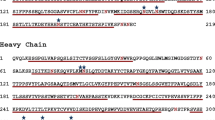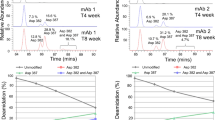Abstract
A peptide mapping procedure was developed to locate regions of a monoclonal antibody, OKT3, that undergo chemical modification as the molecule degrades upon storage. The structures of these peptide degradation products were investigated. Deamidation at specific asparagine residues and oxidation of a cysteine and several methionines were found to be major routes of OKT3 degradation. A unique chain cross-linked degradation product was also observed and characterized. Changing the storage conditions of the antibody affected the relative distribution of degradation products. These results were useful in the development of more stable formulations for OKT3, and the methods can be used in the characterization of other monoclonal antibodies intended for therapeutic use.
Similar content being viewed by others
REFERENCES
M. C. Manning, K. Patel, and R. T. Borchardt. Stability of protein pharmaceuticals. Pharm. Res. 6:903–918 (1989).
P. E. Rao and D. J. Kroon. Orthoclone OKT3; Chemical mechanisms and functional effects of degradation of a monoclonal antibody. In J. Wang and M. P. Born (eds.), Stability of Protein Pharmaceuticals—Case Histories Plenum, New York (1992).
T. W. Thannhauser, Y. Konishi, and H. A. Scheraga. Sensitive quantitative analysis of disulfide bonds in polypeptides and proteins. Anal. Biochem. 138:181–188 (1984).
P. Matsudaira. Sequence from picomole quantities of proteins electroblotted onto polyvinylidene difluoride membranes. J. Biol. Chem. 263:10035–10038 (1987).
K. U. Yuksel and R. W. Gracy. In vitro deamidation of human triosephosphate isomerase. Arch. Biochem. Biophys. 248:452–459 (1986).
W. J. Chazin, J. Kadel, E. Thulin, T. Hofmann, T. Drakenberg, and S. Forsen. Identification of an isoaspartyl linkage formed upon deamidation of bovine calbindin D9k and structural characterization by 2D 1H NMR. Biochemistry 28:8646–8653 (1989).
W. Konigsberg. Subtractive Edman degradation. In C. H. W. Hirs and S. N. Timasheff (eds.), Methods in Enzymology, Vol. XXV Academic Press, New York, 1972, pp. 326–332.
T. Geiger and S. Clarke. Deamidation, isomerization and racemization at asparaginyl and aspartyl residues in peptides. J. Biol. Chem. 262:785–794 (1987).
S. Capasso, L. Mazzarella, F. Sica, and A. Zagari. Deamidation via cyclic imide in asparaginyl peptides. Peptide Res. 2:195–200 (1989).
B. A. Johnson, J. M. Shirokawa, W. S. Hancock, M. W. Spellman, L. J. Basa, and D. W. Aswad. Formation of isoaspartate at two distinct sites during in vitro aging of human growth hormone. J. Biol. Chem. 264:14262–14271 (1989).
B. N. Violand, M. R. Schlittler, P. C. Toren, and N. R. Siegel. Formation of isoaspartate 99 in bovine and porcine somatotropins. J. Protein Chem. 9:109–117 (1990).
S. Clarke. Propensity for spontaneous succinimide formation from aspartyl and asparaginyl residues in cellular proteins. Int. J. Peptide Protein Res. 30:808–821 (1987).
W. Jiskoot, E. Coen Beuvery, A. A. M. de Koning, J. N. Herron, and D. J. A. Crommelin. Analytical approaches to the study of monoclonal antibody stability. Pharm. Res. 7:1234–1241 (1990).
E. A. Kabat, T. T. Wu, M. Reid-Miller, H. M. Perry, and K. S. Gottesman. Sequences of Proteins of Immunological Interest 4th ed., U.S. Department of Health and Human Services, 1987.
R. J. Harris, K. L. Wagner, and M. W. Spellman. Structural characterization of a recombinant CD4-IgG hybrid molecule. Eur. J. Biochem. 194:611–620 (1990).
Author information
Authors and Affiliations
Rights and permissions
About this article
Cite this article
Kroon, D.J., Baldwin-Ferro, A. & Lalan, P. Identification of Sites of Degradation in a Therapeutic Monoclonal Antibody by Peptide Mapping. Pharm Res 9, 1386–1393 (1992). https://doi.org/10.1023/A:1015894409623
Issue Date:
DOI: https://doi.org/10.1023/A:1015894409623




